This post contains affiliate links.
If you’re thinking about getting a composting toilet for your tiny house (or any size house, really) then read this first.
You can always check out the top 5 composting toilets we recommend for tiny houses. But sometimes nothing beats doing it yourself. It’s cheaper, it’s more rewarding, and you’ll appreciate it more because you built it! And yes, you can still keep the smell away. All it takes is sawdust.
It’s a relatively simple project and won’t cost you more than $60 in materials to complete. You might even be able to find scrap materials and build your own composting toilet for free. That sounds better than spending up to $1,750 on composting toilets like the ones I showed you here, right?
There’s nothing wrong with any of the composting toilets on the market. In fact, the ones I mentioned here are pretty awesome. It’s just that not everybody has that kind of money to spend. So why not consider a simple solution like this if you and your family are open to it? Especially if you’re into carpentry already, right? Or if you’re looking to get started, this might be a great first project. So just for inspiration, I wanted to share one of our readers, Nicole’s, DIY Humanure Composting Toilet Project. And I’ve provided resources on how to build your own at the bottom of this post in case you’re inspired to build one too. Enjoy!
Woman’s DIY Humanure Composting Toilet Project

Images © Nicole Martin
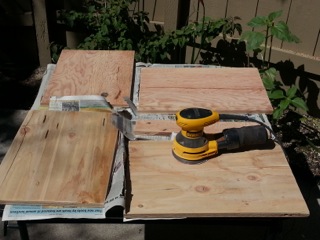
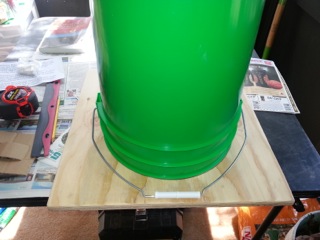

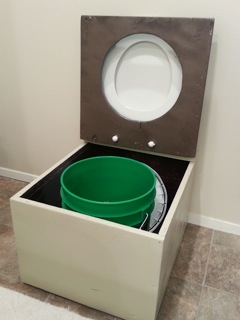
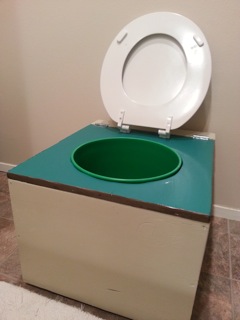

Images © Nicole Martin
Resources
- Humanure Toilet Project (how to build your own)
- Composting Toilet Plans
- Humanure Handbook (Free Web Version)
Our big thanks to Nicole Martin for sharing her DIY composting toilet project with us! Thanks Nicole!
You can share this DIY Humanure Composting Toilet Project with your friends and family for free using the e-mail and social media re-share buttons below. Thanks.
If you enjoyed this tiny house story you’ll absolutely LOVE our Free Daily Tiny House Newsletter with even more! Thank you!
This post contains affiliate links.
Alex
Latest posts by Alex (see all)
- Escape eBoho eZ Plus Tiny House for $39,975 - April 9, 2024
- Shannon’s Tiny Hilltop Hideaway in Cottontown, Tennessee - April 7, 2024
- Winnebago Revel Community: A Guide to Forums and Groups - March 25, 2024




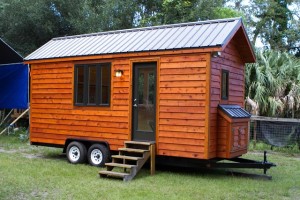

Ah, what’s old is new again.
My mother, who is now 90 years young, has told me in the past that when she was a little girl, one of her mother’s job’s was to pull the “honey bucket” out from a space accessed from the outside of the house (the bathroom was inside the house) and dump the refuse into a nearby river.
There were a couple of buckets stored in that place, so one could be moved into place while the other was being emptied.
According to Mom, this was usually a once-a-day job.
What would be really cool, is if someone could create a “Composting System”, where a regular flush toilet could be used, but the refuse would end up in a septic tank that would also double as a composting bin.
Dean, there is such a thing! Several actually. The only hold up is that they are prohibitively expensive. They are more suited to large beautiful homes or hotels than a tiny house. Here’s a start http://www.letsgogreen.com/centrexwaterflush-desc.html
…and just when you think you have an original idea…
Thanks for the link Dana. I’ll check it out.
Dean, one word…genius!
Thank you, Linda.
Just makes sense. A flush toilet is, essentially, a “powerless” item. You open a valve allowing water to flow and physics does the rest.
My thought about the septic tank would be to make it from a permeable material. That way, the solid waste is held in, but the liquid waste flows through. That way, the compost doesn’t become such a slurry.
The alternative is to pay some company to come and pump your septic tank….but what do they do with the waste?
Dean that is a good idea! I know there are places that do something similar to that and use it in a methane digester. I saw this in MotherEarthNews and had to search to find it but I did… google is your friend! http://www.motherearthnews.com/renewable-energy/home-methane-digester-zmaz81mjzraw.aspx
Joe – Apologies for the late reply. Just seeing this post now. Thanks for the compliment and the link.
I’ll check it out.
Have two buckets – one for urine which can be as simple as a funnel with a pipe leading to the outside garden; the other for #2. Apparently the smell is lessened quite a bit this way and cleanings would be less frequent. I’ve had the thought that a bamboo patch would be a great use for humanure compost – it’s very nutrient needy and you’d be turning your poo into building materials! 🙂
Where is everyone getting their sawdust?
We just use peat moss from the garden center. Between the two of us, it lasts for 3-4 months. But you can get the sawdust from Home Depot… They usually have trash bins full of it.
My husband and I are thinking of converting a bus into an RV for a year-long stay in a housing challenged area. My only hang up is where to put the waste? If we are using a composting toilet and do not install and RV system, what do we do with the poo?
You have a few options… You can just put a bag in the bucket and when it’s full, put it in the outgoing trash. Or you can build a special container to hold the humanure….when it’s done composting you can put it on your flower beds. There is also the incinerator toilet(expensive and uses a lot of electric) ….
We buy compressed wood shavings at a local farm and tractor supply. Pretty inexpensive, easy to handle and smell great! We have been doing it that way, in the summertime, for going on 5 years. I wish we were doing it all year!
Alex, Could we talk about urine diverters? We are all adults, and i never see examples or discussions on how to make one. there must be several ways to do this? Hospitals use something called “HATS” for collecting only urine for lab tests, could something like that be used etc. I’d like to know what others are doing. Joe Jenkins, says nothing about it if i am correct. will others please share ?
Donatella, I picked up a bag of wood pellets (sold for wood burning stoves) at Lowes for about $6. I keep the pellets in a 5 gal bucket in the bathroom and each morning put ~one cup of dry pellets in a container that can hold about 8 cups add water and presto it expands and is ready to use.
I heard of a cabin somewhere very cold in the winter. I think this was in the 19th century. There was a small hole in the wall through which a hollow cow horn was placed. It formed a funnel and one urinated into the large end and the urine went outside so that the person urinating didn’t need to go out in the cold. Moving the urine further from the building wouldn’t hurt.
With the ‘cow horn’ idea, I would suggest the funnel or wall urinal with a drain hose connection. That way you can drain the liquid to another location such as a collection bucket or ditch. Be careful of the location you park as the local sanitation rules may not allow the drain hose. Some composting toilets use a drain hose to a ‘pit’ in the ground that might be permitted in some locations. That ‘pit’ acts like a mini septic system.
The Humanure Handbook is a great resource for all of this, too. We built our composting toilet 11 years ago , and it has worked great since. There is no way we would just throw it into a river, or dump it just anywhere. We compost it, along with everything else that normally goes into compost. When bin is full, we cover with black plastic to really “cook it”, and in 3 months in our Hawaii climate, it is the most beautiful compost ever. You could never tell what it was composed of, it is rich, soil that only smells like good soil should.
In our area, central Illinois, not only septic system companies, but the municipal sewage system, load the “fertilizer” into tanker “honey wagons” and discharge it into cornfields nearby. So, it goes into the corn and soybeans that the cattle and hogs eat, and you eat them, and the cycle continues, as it should. The problem I see with this system is that this rich fertilizer is only put on nearby, with the far away fields in ultra rural areas not getting any recharge.
In my dad’s native Netherlands village, a farmer came once a week and replaced the barrel under the outhouse with an empty one. Same idea, without the middleman.
Penny – Why do outlying farms not benefit from the richened soil?
Is it only available to “subscribing” farms, or is there a logistics problem of keeping the soil “good” for the length of time it would take to get the soil to those outlying farms?
I find this a highly intriguing dilemma whose solution could have far reaching value.
OOPS – I meant Rich Fertilizer, not Richened Soil.
Hi Dean, It is too expensive to truck that heavy material very far. Here the farmers are paid to allow spreading on their fields. Remember this is municipal solid waste, not just pure humanure, with everything city people flush down their drains. It has been through a tertiary treatment plant, but still I don’t think I’d want it on my land.
I think it is said that every great empire falls when its food base is desertified. (think–Anasazi in New Mex/Arizona, Romans using North Africa for wheat, earliest civilizations in the Middle East) We are continually pulling nutrients and trace elements from the far reaches of our land, and depositing them around our cities in what can become toxic amounts. Much wiser for each homestead to contain/recycle its own waste!
It is because composted human waste should never be put on edible plants. If anything went wrong, there could be living fecal pathogens in the compost. If this is placed on food, the food would be contaminated. I think if you were very careful it would be fine.
A note about urine separation, check out the site Rich Earth Institute.
Brattleboro, Vt has the only community Peecycling program in the country.
I have good instructions on my site on a DIY composting toilet. Wood is not ideal, because it will absorb odors and eventually rot. I don’t like the humanure system because it requires that you add a massive amount of sawdust to your toilet. This creates a mess, and means you are going to be emptying your toilet frequently. I do not want my toilet to be a central part of my life. Use a urine diverting toilet, install a fan, and dehydrate the material rather than compost it. This will be odor free, and capacity will be huge. Then you compost the semi dehydrated solid waste outside in a bin. This approach is drastically better than the humanure approach, and easier.